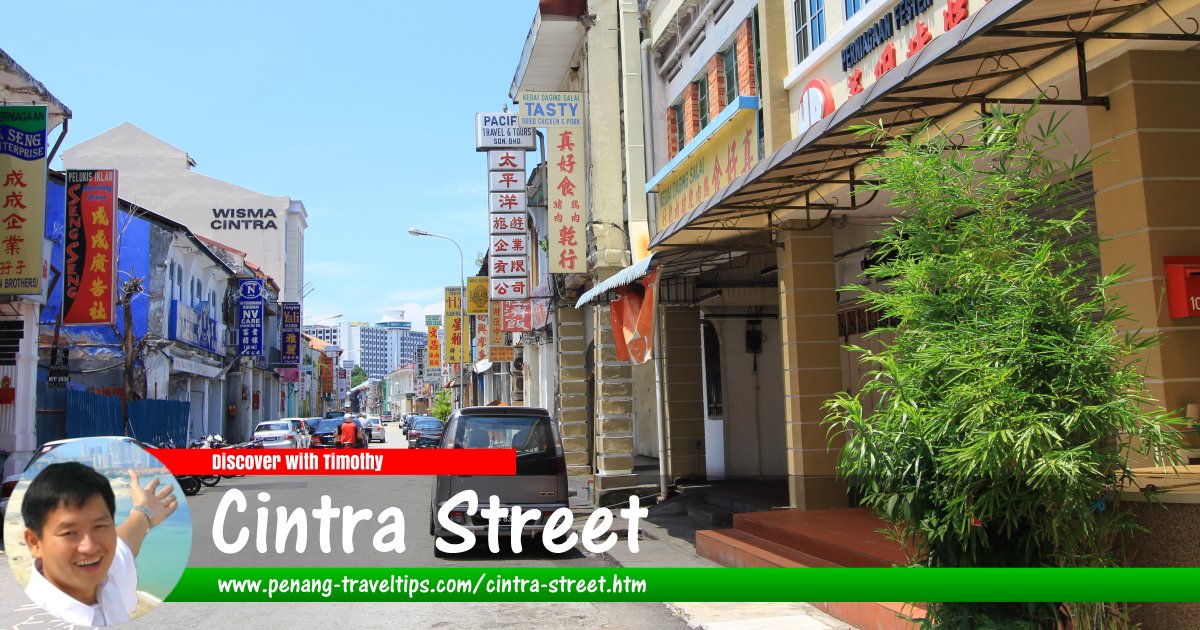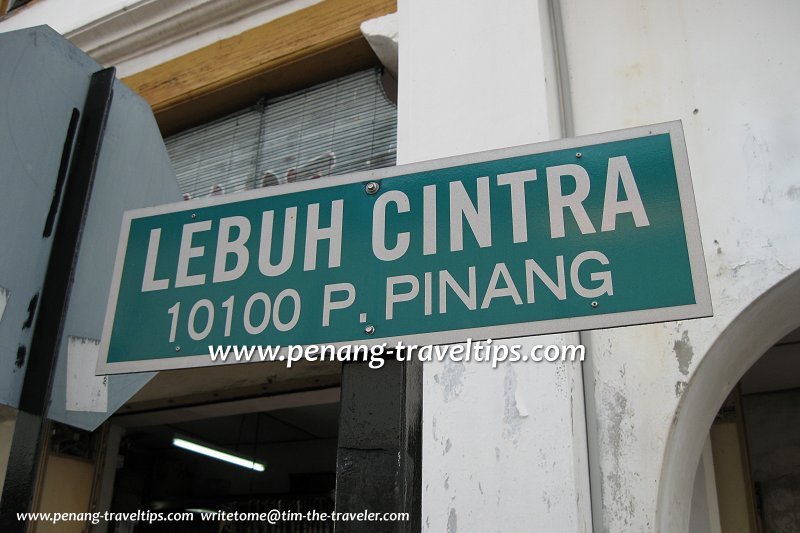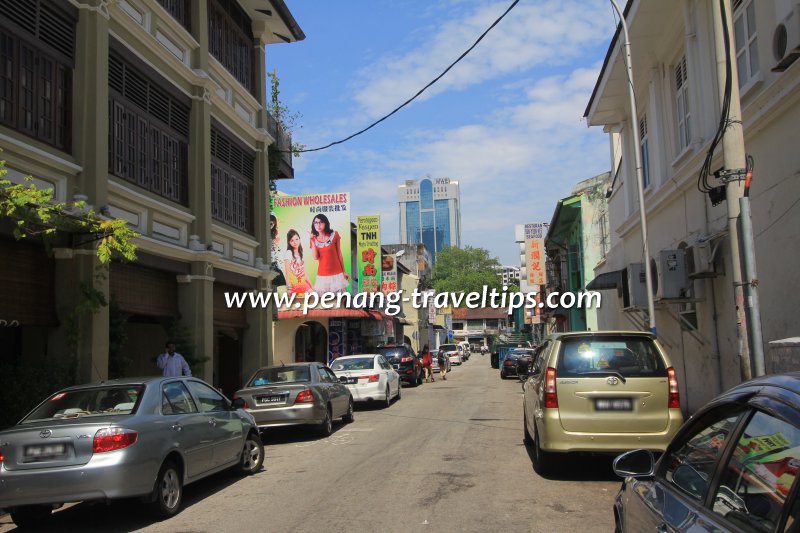 Cintra Street, George Town, Penang (17 April 2011)
Cintra Street, George Town, Penang (17 April 2011)
Cintra Street or Lebuh Cintra is a street within the Chinatown area of George Town, Penang. It starts at Chulia Street and ends at Kimberley Street, across from Sungai Ujong Road. It is intersected by Campbell Street. Kampung Malabar also ends at Cintra Street.
Cintra Street was named after an event that was totally unrelated to Penang, safe except for the fact that one of the protagonists was Sir Arthur Wellesley, after whom Province Wellesley was named after. The aforementioned event was the signing of the Convention of Sintra, named after the Portuguese town of Sintra (written Cintra in English), a municipality within the District of Lisbon. The Convention of Sintra allowed French troops to withdraw and evacuate from Portugal, which they had earlier invaded, following their defeat by Anglo-Portuguese forces led by Wellesley.
The Convention of Sintra was an embarrassment as well as a disgrace to the United Kingdom, because two incompetent superiors to Wellesley, namely Sir Harry Burrard and Sir Hew Dalrymple, allowed the defeated troops to "escape" any form of punishment. They were allowed free transport and travelled loaded - meaning they went home with valuables that they had looted. Wellesley wanted to fight, but was overruled by his superiors. An official inquiry was held, the result of which saw Wellesley returning to active duty, which the two superiors were quietly pressured into retirement.
For much of the 19th and early 20th century, Cintra Street was a red light district. The section between Kampung Malabar and Campbell Street was where brothels with Japanese prostitutes were found. These prostitutes, called Karayuki-san, meaning "Ms Gone Overseas", were girls from impoverished rural Japanese families. Many are believed to be buried at the Japanese Cemetery (just as is the case with the Japanese Cemetery in Sandakan and Banda Street in Singapore). The section of Cintra Street between Campbell and Kimberley Street was also another red light area, with cheap brothels stocked with prostitutes from other races.
Today we can no longer find such prostitution dens operating along Cintra Street - not openly, anyway. In the 1960's, People's Court, one of the earliest housing estates in Penang, was built to provide housing to low-income earners. It is today the heart of Chinatown with a number of popular Chinese restaurants. The most popular is De Tai Tung. Foo Heong Restaurant was famous in the 1970's but has since lost its lustre. Also along Cintra Street is a famous Hum Chin Peng stall and a herbal tea stall.
Local names for Cintra Street
Cintra Street is presently called Lebuh Cintra. In the old days, it was known in Penang Hokkien as Jit3pun1 Kay 日本街 , because of the presence of the Japanese prostitutes in that area, Phak1 Phau3 Kay1 拍袍街
, because of the presence of the Japanese prostitutes in that area, Phak1 Phau3 Kay1 拍袍街  ("low-class brothel street") and Sin3kay1 Hnuai3 Kay1 新街橫街
("low-class brothel street") and Sin3kay1 Hnuai3 Kay1 新街橫街  meaning road that is crossways from Campbell Street.
meaning road that is crossways from Campbell Street.
 Map of Cintra Street, Penang
Map of Cintra Street, Penang
Hotels along Cintra Street
- Campbell House
 (GPS: 5.4182, 100.33358)
(GPS: 5.4182, 100.33358) 
- Cintra Heritage House
 (GPS: 5.418982, 100.334225)
(GPS: 5.418982, 100.334225) 
- Nam Keng Hotel
 (GPS: 5.41866, 100.33407)
(GPS: 5.41866, 100.33407) 
- Inn Residence 18
 (GPS: 5.41669, 100.33293)
(GPS: 5.41669, 100.33293) 
- Malabar
 (GPS: 5.41872, 100.33384)
(GPS: 5.41872, 100.33384) 
 Coffee Shops & Restaurants along Cintra Street
Coffee Shops & Restaurants along Cintra Street
- Foo Heong Restaurant (GPS: 5.41767, 100.33329)

- Hsiang Yang Fast Food
- Hum Chin Peng Stall on Cintra Street (GPS: 5.41795, 1000.3335)

- Sin Guat Keong Coffee Shop (facing Kimberley Street) (GPS: 5.41642, 100.33274)

- Tai Tong Restaurant (GPS: 5.4177, 100.33356)

- Wen Chang Chicken Rice Shop (GPS: 5.41736, 100.33332)

Street Art on Cintra Street
- "Same Taste, Same Look" Sculpture (GPS: 5.41656, 100.33278)

- "Spy" Sculpture (GPS: 5.41858, 100.33382)

Historic Buildings on Cintra Street
- 100 Cintra Street (GPS: 5.41701, 100.33287)

Commercial Properties on Cintra Street
- Wisma Rasidah (GPS: 5.41753, 100.33321)

 Businesses on Cintra Street
Businesses on Cintra Street
- Kam Thong Motor
- NV Care Funeral Service (GPS: 5.41709, 100.33293)

- P.H.G. Enterprise (electronics) (GPS: 5.41652, 100.33261)
- Seng Seng Advertising Services (car number plates) (GPS: 5.41692, 100.33283)
- Weng Heng Medical Hall
Food Recommendations
The following item was recommended by a member of the Penang Hawker Food Facebook Group.Recommended Koay Teow Thng in Penang
The koay teow thng at a roadside stall on this street was among those recommended at least one member.Details
Getting there
From the Komtar Bus Terminal, walk along Jalan Ria, cross Jalan Dr Lim Chwee Leong and enter Jalan Sungai Ujong. Walk along Jalan Sungai Ujong until Kimberley Street. Cintra Street is located across Kimberley Street. Cintra Street sign (17 December 2008)
Cintra Street sign (17 December 2008)
 Cintra Street (17 December 2008)
Cintra Street (17 December 2008)
 Cintra Street, looking towards Chulia Street (25 January 2013)
Cintra Street, looking towards Chulia Street (25 January 2013)

Cintra Street plaque (17 December 2008)

List of Streets in Penang and Streets in Malaysia

Copyright © 2003-2025 Timothy Tye. All Rights Reserved.

 Go Back
Go Back